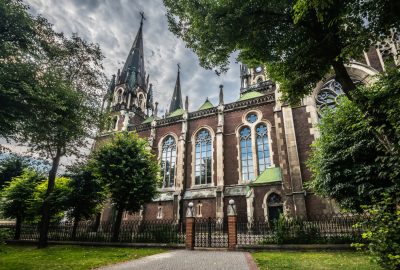Lviv (in Russian: Lvov) takes its name from Leo (Lev) I of Galicia. Unlike most large cities in this part of Europe, the whole Western part of Ukraine didn’t get annexed by the USSR until 1939, which allowed them to secure most of their heritage. People in West Ukraine are very proud of their history, obsessing over Cossacks and looking down upon anyone that even utters a word in Russian. The Russian speaking people are considered to be betrayers after the Russian annexation of Crimea. And the people in the Eastern part of Ukraine such as the Donbass area accuse people in Lviv and the rest of Western Ukraine of heating up the nationalistic sentiments. Labels as “fascists”, “communists” and even “Nazis” have become fashionable again and a reasonable debate based on real facts and valid arguments seems to be out of the question. Ukraine means borderland and that says a lot if not all. Ukraine is on the divide of many things. The gap between the Eastern and Western part, be it in culture, language and mentality, has become too deep. As is the case with most things in life: nothing is black or white and there are no simple solutions to complex issues. But political powers and some media on both sides like to simplify matters and by doing so they are playing with fire. Hopefully this great country will recover and leave the troubled times behind somehow.

The opera house in Lviv, officially named Solomiya Krushelnytska Lviv State Academic Theatre of Opera and Ballet, has an extraordinary and beautiful location above the Poltva River
If you have never visited this country you should put it on top of your travel-bucket list. Every one who has visited Ukraine will admit that the hospitality is overwhelming and that the women are breathtakingly beautiful. That’s a matter of fact. So what are you waiting for? Lviv belongs together with Odessa and Kiev (Kyiv) definitely to the most beautiful and interesting cities you can visit in Ukraine. The UNESCO decided that Lviv’s Old Town is worthy of being included in the World’s Heritage list with its peculiar mix of architectures ranging from Renaissance to Gothic. The old centre looks like Hogwarts with its gargoyles, stone stairs and cobblestone. Not many people consider this part of Europe a tourist destination and that’s a good thing; you can visit while it’s not swarmed by tourists, Ukrainians are friendly people and it’s getting easier to communicate in English in restaurants and even on the streets.
As a matter of fact, Lviv is much more Central European. Compared to all the orthodox churches in Kiev, it feels more like Prague or Krakow. The Polish still claim that they built Lwów (as the name goes in Polish) and that it’s a Polish city. But let’s not forget that Poland is a nation that literally has beef with half of the world, for the dumbest reasons. There has been an influx of Ukrainian immigrants in Poland. They are universally hated because “their Polish isn’t on point and they’re taking our jobs”; classic redneck rhetoric to my opinion. Lviv is a city of churches: the Church of the Transfiguration, the Jesuit Church (Church of the Most Holy Apostles Peter and Paul) and many others. Keep in mind that summer is the wedding season and all the places of worship will be crowded. It can be a bit awkward; checking out a church during such a ceremony. Visit the Armenian Cathedral (the Armenian Cathedral of the Assumption of Mary), build in 14th century and see how the Armenian’s history is closely tied to Ukraine. You can scout all the sights from a vista on top of the city hall. It’s a tough climb up a funny-smelling, claustrophobic staircase but the view is worth the effort. Lviv is also known as the city of books, a host to various expos. You can buy books at flea markets all over town, most cafes and restaurants have a bookshelf with titles covering all sorts of topics.

The Church of Saints Olha and Elizabeth, located between the railway station and the old Town of Lviv, was originally built as the Roman Catholic Church of St. Elizabeth but serves today as the Greek Catholic Church
As usual, the best spots are outside of the beaten path. Unconventional tourist favourites like the Coffee Manufacture at the Old Town square, or the Chocolate Manufacture (https://www.chocolate.lviv.ua/) are my favourites. They’re pretty big on coffee and chocolate in Ukraine, which was a surprise for me in first instance. Lviv has two citadel buildings, both hidden in a forests. They are complete opposite of each other. One is abandoned, crumbling and possibly hunted, while the other got renovated and is now a 5* hotel. No sightseeing tour is complete without staples such as the Lychakiv Cemetery, one of the most picturesque in Eastern Europe. There is also an interesting range of museums in Lviv such as the National Museum, Pharmacy Museum, History Museum; take your pick. Let’s not forget about the important stuff, Lviv is a university city, with lots of students and with those comes party culture and nightlife. Craft beers are immensely popular, Pravda Beer Theatre (https://www.pravda.beer/) located at the Old Town Square was opened recently and is quickly becoming a staple on the nightlife map of Lviv. Dublin Pub, Whiskey Bar and many more are located around the same area. I almost forgot; if you’re into folk music from these parts you should definitely give Dakhbrakha a shot. I’m in love with that band.



No one commented yet. Be the first.